Argument analysis: Now, three options on college affirmative action
Analysis
The mystery of why the Supreme Court chose to take a second look at the challenge to the University of Texas at Austin’s consideration of race in choosing new students was partly solved in a prolonged hearing on Wednesday morning. The case, it would appear, now comes down to three options: kill affirmative action nationwide as an experiment that can’t be made to work, kill just the way it is done at the Texas flagship university because it can’t be defended, or give the university one more chance to prove the need for its policy.
The Court bored deeply into the details of the Texas policy, in a hearing lengthened by more than a half-hour beyond the scheduled sixty minutes, and marked by heated exchanges and deep emotions, especially when discussing the academic skills of blacks and Hispanics as university candidates.
Because the first two options that seemed to emerge would be momentous rulings, it may be that the Court would not want to do either with only an eight-member Court. Justice Elena Kagan, because of her past involvement with this very case while a government lawyer, is not taking part, and a shortened bench might not want to act so boldly. But even the Justice who talked most about another chance for the university — Anthony M. Kennedy — did not seem entirely convinced that it would make a difference.
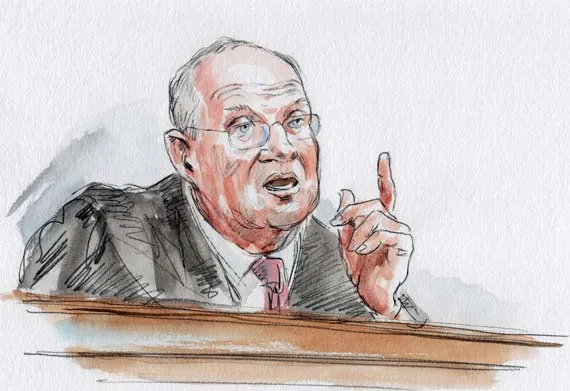
If the Court, after weeks of private deliberation, ultimately cannot assemble a clear five-Justice majority among the eight who will decide, that could lead to a simple order by an evenly divided Court with no opinion but with the practical effect of upholding the Texas program as is. That would provide no guidance for other public colleges and universities. Because no faction among the Justices would seem to want that, there is likely to be a strenuous effort to find a common ground — as there was last time, two years ago, when a seven-to-one decision returned the case to lower courts for another look, with modest new guidance.
There was no doubt on Wednesday that there are three and probably four Justices who have grown deeply skeptical, if not hostile, to affirmative action in general. That would include, for sure, Justices Samuel A. Alito, Jr., Antonin Scalia, and Clarence Thomas. (Although Thomas did not ask any questions today, his views on the issue are well known.). A fourth could be Chief Justice John J. Roberts, Jr., who openly fretted about whether the time would ever come when race would no longer be used in affirmative action on college campuses. He noted that, twelve years ago, the Court had predicted that there would be no need to use race in college admissions within twenty-five years, but about half of that time is now gone.
Equally, there was no doubt that there are three Justices clearly on the university’s side — Justice Ruth Bader Ginsburg, who would have upheld the plan two years ago and was the lone dissenter in that ruling, and Justices Stephen G. Breyer and Sonia Sotomayor. Sotomayor was a dogged questioner of the attorney challenging the Texas plan, Bert W. Rein of Washington, D.C. She was so excitedly involved that, twice, the Chief Justice cut her off in order to let Rein finish a thought.
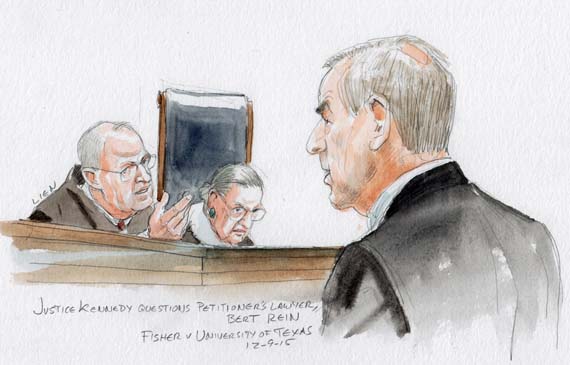
Justice Kennedy displayed some new skepticism about the Texas program, but in his very first question complained that nothing really new was now before the Court. The questions by some of his colleagues about how the Texas program works, Kennedy said, brought up “the kind of things we should know.” But, he said, “we’re just trying the same case again.”
He asked Rein whether the challengers had opposed having the case, after being decided by the Justices, returned to a federal trial court rather than having the U.S. Court of Appeals for the Fifth Circuit decide it without new evidence. The case actually has never gone to a full trial in the district court; it was decided on summary judgment, meaning on the legal filings by lawyers, without witness testimony. The university asked the Fifth Circuit for a chance to put in more evidence before a district judge, but the challengers opposed that request, and the Fifth Circuit refused to do so, expressing doubts there was much more to say.
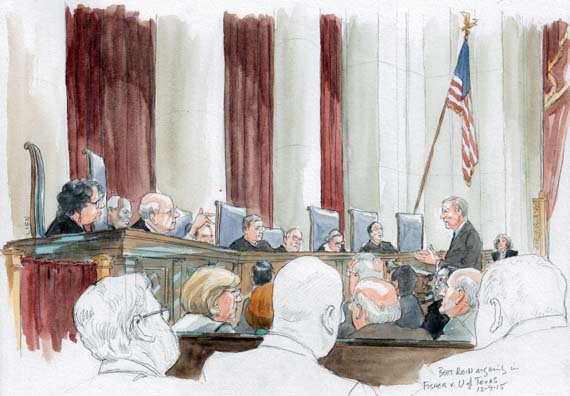
Kennedy would suggest, a couple of times, that the case might be sent back to the district judge, if the university had more to put in the record to support the program. But when the Justice directly asked the university’s lawyer, Washington attorney Gregory G. Garre, what more the university might seek to put forth, Garre’s answers were meandering and imprecise. Kennedy responded that it did appear that the university “would not put in more evidence than we have now.” Garre in turn protested that it could offer “plenty of additional evidence.”
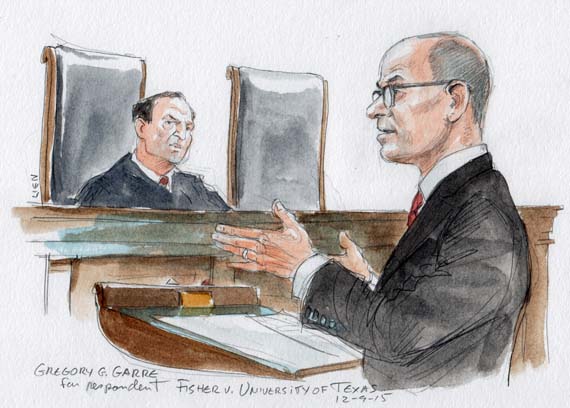
Kennedy did not relent. Why, he asked, couldn’t the existing record be used, supplemented by drawing some “inferences” from it? When Garre replied that the Court could do that, in the university’s favor, the Justice responded unpleasantly: “You’re saying there should be a remand only if we lose [in the Court this time]; that’s what you’re saying.” Garre said no, and then pleaded for the chance to “fill out the record.” But it may have been a gesture too late.
Remand, however, remained a topic of discussion throughout the argument. Justice Breyer seemed at times to endorse the idea of a new review in the trial court. But it was clear that the challengers would be disheartened if that were the result. Rein told the Court in his final remark: “Lawyers have to come to the court with a record. They can’t make it up later. They [university lawyers] said they were ready for summary judgment. And the Court of Appeals said there was no need for more record.”
The third lawyer to appear, U.S. Solicitor General Donald B. Verrilli, Jr., spent most of his time urging the Court to preserve the option for universities to achieve racial diversity because of society’s strong need for minority leaders who could function effectively, in the military and business, in racially diverse environments. He also tried to shore up the university’s policy, using statistics to show that the number of minorities at the university had been rising steadily under the program in use since 2004 but now under new attack.
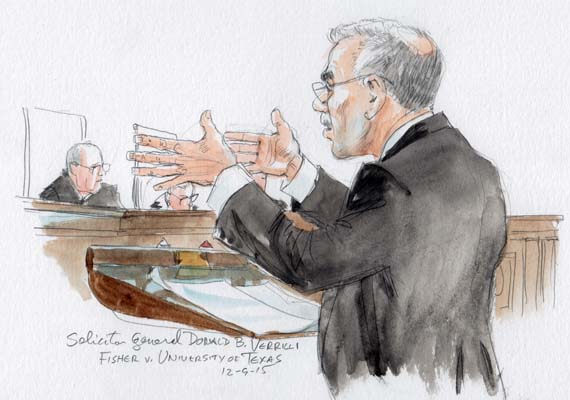
That program replaced a program of automatic admission to the university in Austin for any applicant who had graduated in the top ten percent of the graduating class in any Texas high school. The challengers contend that that program was sufficient to help the university increase minority enrollment, so there was no need to add the current policy that takes race into account, as one factor, in looking at each applicant “holistically” in choosing the best candidates for admission.
One of the constitutional arguments that the challengers are now emphasizing anew, and pressed again on Wednesday, was that the university has been engaging in racial stereotyping by disparaging the academic skills of minority students who graduated in the top ten percent of racially segregated schools in Texas. Both Justice Alito and Justice Scalia, in efforts to defend the top ten percent plan’s success, reacted negatively to that perception of the university’s justification — a justification which the university denies that it has.
But Scalia’s arguments became quite clumsy, and raised some eyebrows, when he suggested that maybe the University of Texas needs fewer minority students, and he suggested that many of them find that the classes are “too fast” for them at such high-rank institutions, and thus prefer to go to lower-ranked, “slower-track schools.”
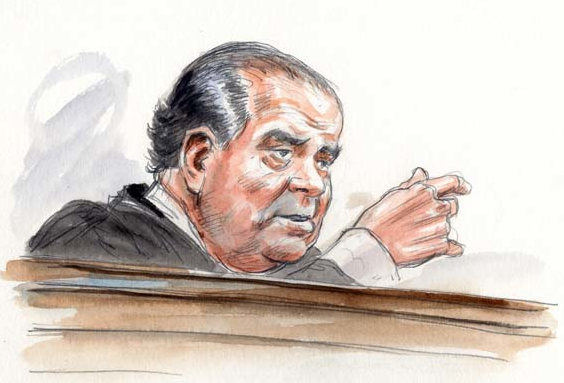
Garre, the university’s lawyer, responded by reminding Scalia that the Supreme Court had rejected that very type of argument a dozen years ago in the last major ruling to uphold a college affirmative action plan, for the University of Michigan Law School. “Frankly,” Garre said, “I don’t think the solution to the problems with student body diversity can be to set up a system in which not only are minorities going to separate schools, they’re going to inferior schools. . . . Now is not the time and this is not the case to roll back student body diversity in America.”
It was the closing comment on behalf of the university, and the intensity of it suggested that Garre had found much of Wednesday’s hearing potentially discouraging. And his comment seemed directed at Justice Kennedy, in the hope that Kennedy would not be comfortable casting the decisive vote that ended affirmative action on American campuses. If those were his thoughts, the hearing provided some foundation for them.
Posted in Analysis, Merits Cases
Cases: Fisher v. University of Texas at Austin